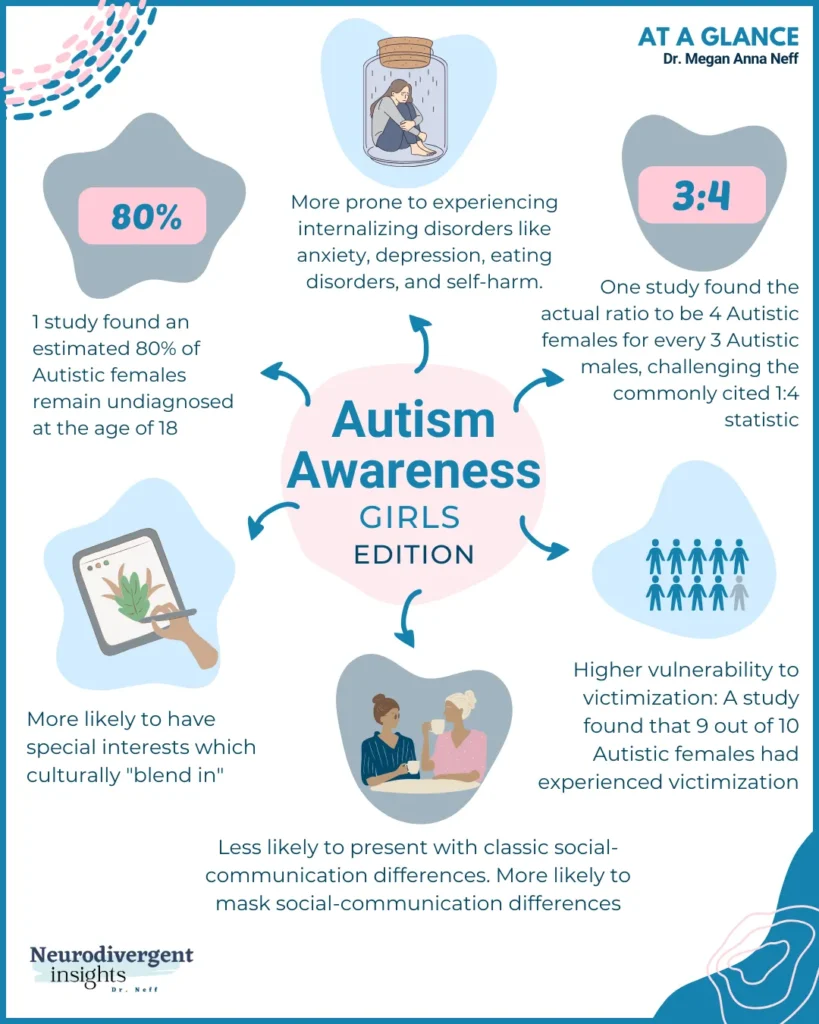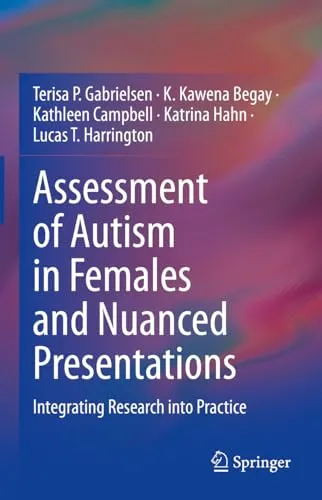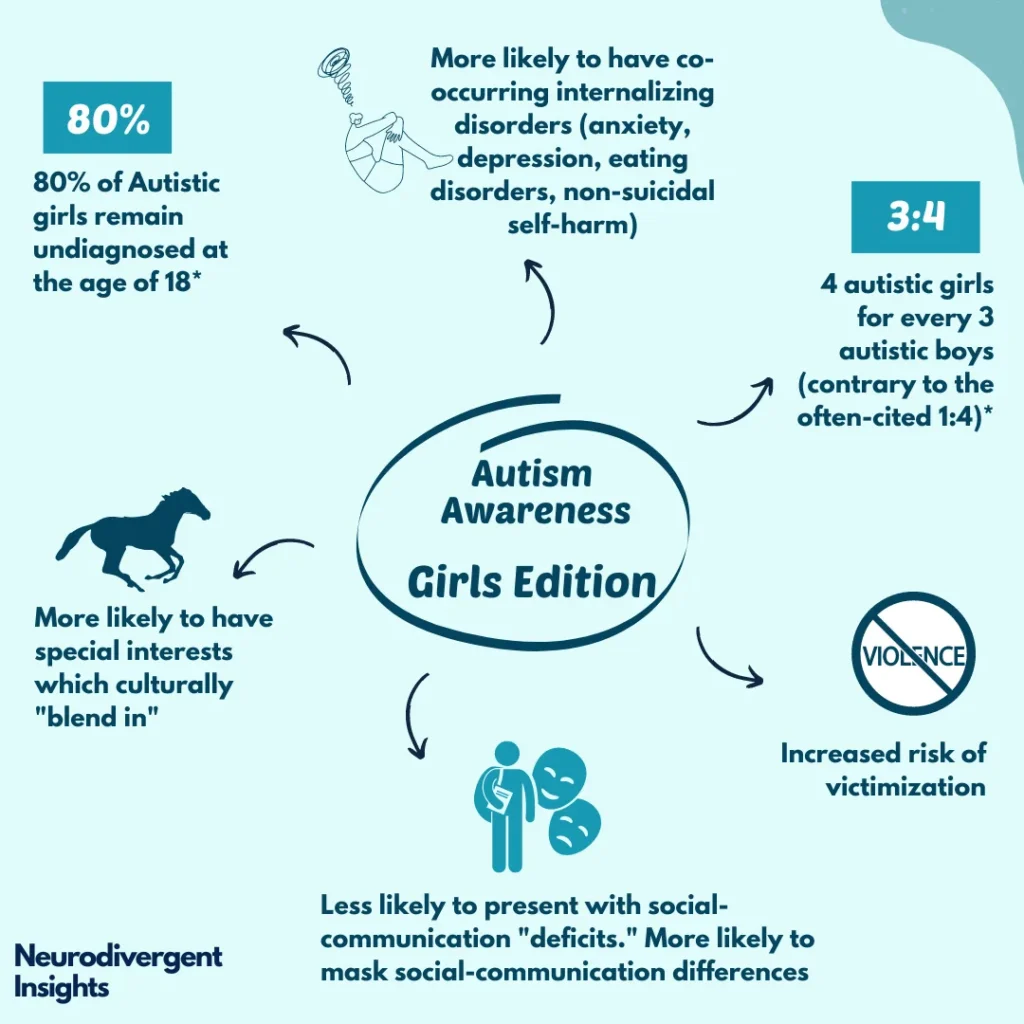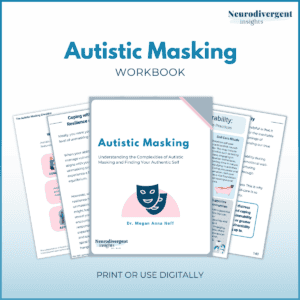Autism Awareness Special Edition: The Invisible End of the Spectrum – Girls and Women

April marks Autism Awareness Month, and this year, I’m launching a “Special Edition” series dedicated to highlighting the less recognized and often overlooked aspects of autism. While some argue that the time for awareness has passed in favor of acceptance, I believe the journey towards true acceptance requires ongoing awareness—especially for underrepresented groups. This mini-series aims to bring these groups into the spotlight, beginning with girls and women. In subsequent weeks, we will explore the experiences of the Trans community and delve into the discrepancies in diagnosis within BIPOC communities.
The Underdiagnosis of Girls and Women
Autism has historically been viewed through a male-centric lens, leading to a significant gap in the diagnosis and understanding of Autistic females. It turns out the gap is not because autism is less common in females, but rather due to bias in research in medicine. Several gaps contribute to this such as:
Diagnostic tools normed primarily on males
A majority of autism research focused on males
Cultural myths and stereotypes reinforcing autism as a “boys’ condition”
The Real Ratio: Challenging Old Statistics
A pivotal study by McCrossin (2022) challenges the often-cited male-to-female autism ratio of 4:1. Through mathematical projections that account for diagnostic bias, McCrossin suggests the true ratio leans towards 3:4, indicating a staggering 80% of autistic females remain undiagnosed by the age of 18. This revelation underscores the urgent need to reassess our diagnostic criteria and approach to research.
Brain Differences and Impact
Recent studies, including those by Supekar et al. (2022), have begun to illuminate sex-specific brain differences between autistic females and males. These findings indicate that autism affects different brain regions in females, with impacts on:
Fine motor skills
Executive functioning
Emotional regulation
Interestingly, these differences often result in less pronounced social-communication challenges, contrasting with the prevailing stereotypes of autism. Females are also more likely to have more intense sensory sensitivities than Autistic males.
Cultural Blending and Masking
Autistic girls and women frequently go undetected due to Autistic masking and the tendency to possess interests that culturally blend in. While our special interests may exhibit atypical intensity, the subjects themselves—ranging from humanitarianism and religion to animals and pop culture—often don’t deviate from the cultural norms. This phenomenon of “cultural blending” renders our autism less apparent than those with more atypical interests. Moreover, the tendency to mask Autistic traits also leads to reduced identification of Autistic girls and women (Hull et al., 2020).
Increased Risks and Co-occurring Conditions
The experience of autistic girls and women is fraught with challenges, which is only exacerbated when we don’t receive accurate identification. For example we have:
Higher rates of victimization. One study found that 9 in 10 Autistic females had been sexually victimized (Cazalis et al., 2022)
Increased likelihood of internalizing disorders (anxiety, depression, eating disorders, self-harm etc.)
Greater risk of co-occurring physical conditions (e.g., endocrine and reproductive health issues, epilepsy, autoimmune diseases) (Kassee et al., 2020)
Pathways to Better Diagnosis and Understanding
Recognizing the need for more inclusive diagnostic tools, Brown and Attwood, among others, have developed an autism assessment normed on girls and non-binary individuals. Additionally, the CAT-Q offers insights into the extent of social masking, which can help identify Autistic girls and women who mask.
Further Reading and Resources
For those interested in learning more about the nuanced experiences of autistic girls and women, links to the assessments and related books are provided below:
Assessment of Autism in Females and Nuanced Presentations: Integrating Research into Practice (Book)
Is This Autism? (Book)
Brown and Attwood and others have developed an autistic instrument normed off of girls and non-binary people! To see/use their assessment you can find it here. And you can find their article here. Another great assessment for girls is the CAT-Q which measures the level of social masking.
As we continue to fight for Autism acceptance, it’s essential to continue to integrate autism awareness into the fabric of our advocacy work.

Citations
Brown, C. M., Attwood, T., Garnett, M., & Stokes, M. A. (2020). Am I autistic? Utility of the girls questionnaire for autism spectrum condition as an autism assessment in adult women. Autism in Adulthood, 2(3), 216-226.
Cazalis, F., Reyes, E., Leduc, S., & Gourion, D. (2022). Evidence that nine autistic women out of ten have been victims of sexual violence. Frontiers in behavioral neuroscience, 16, 852203.
Cauvet, É., Van’t Westeinde, A., Toro, R., Kuja-Halkola, R., Neufeld, J., Mevel, K., & Bölte, S. (2020). The social brain in female autism: a structural imaging study of twins. Social cognitive and affective neuroscience, 15(4), 423–436. https://doi.org/10.1093/scan/nsaa064
Hull, L., Petrides, K. V., & Mandy, W. (2020). The female autism phenotype and camouflaging: A narrative review. Review Journal of Autism and Developmental Disorders, 7(4), 306-317.
Jack, A., Sullivan, C. A., Aylward, E., Bookheimer, S. Y., Dapretto, M., Gaab, N., … & Gupta, A. R. (2021). A neurogenetic analysis of female autism. Brain, 144(6), 1911-1926. https://doi.org/10.1093/brain/awab064
Kassee, C., Babinski, S., Tint, A. et al. Physical health of autistic girls and women: a scoping review. Molecular Autism 11, 84 (2020). https://doi.org/10.1186/s13229-020-00380-z
McCrossin, R. (2022). Finding the True Number of Females with Autistic Spectrum Disorder by Estimating the Biases in Initial Recognition and Clinical Diagnosis. Children, 9(2), 272. MDPI AG. Retrieved from http://dx.doi.org/10.3390/children9020272
Supekar, K., De los Angeles, C., Ryali, S., Cao, K., Ma, T., & Menon, V. (2022). Deep learning identifies robust gender differences in functional brain organization and their dissociable links to clinical symptoms in autism. The British Journal of Psychiatry, 1-8. doi:10.1192/bjp.2022.13

Megan Anna Neff

Welcome! I’m Dr. Neff. I am a late-in-life diagnosed Autistic-ADHD Psychologist. Welcome to my little corner of the internet where I love talking about all things mental health, neurodiversity and wellness.








